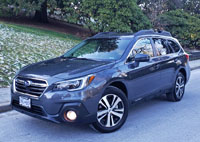
Subaru has long provided a nicely balanced lineup of performance-oriented yet practical cars and crossover SUVs, with the Outback not only typifying this ideal, but together with the smaller compact Crosstrek it actually bridges the gap between family wagon and sport utility.
The Outback’s best of both world’s design means that it’s always been a strong seller for Subaru, but I think it would do even better if more mid-size crossover SUV buyers knew just how roomy it is inside. Despite its lower overall height, the Outback’s 1,005 litres (35.5 cubic feet) of dedicated cargo capacity and 2,075 litres (73.3 cubic feet) of space when the rear row is flattened is much more capable of swallowing up gear than Nissan’s Murano and Chevy’s new Blazer, while it’s on par with Ford’s Edge, Hyundai’s Santa Fe, and even Jeep’s off-road dominating Grand Cherokee.
Subaru could make it even more accommodating if they’d offer a second-row centre pass-through, mind you, or better yet 40/20/40 split-folding rear seatbacks like some premium European brands, but the Outback does include a convenient set of cargo wall-mounted levers for laying its 60/40-split seats flat automatically, while a nice retractable cargo cover and rugged available cargo mat make it a perfect companion for the majority of family hauling duties such as carting four individuals plus their ski/snowboard gear up to the slopes.
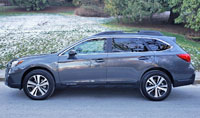
That’s when you’ll be glad for the Outback’s standard all-wheel drive, and that it’s not just any AWD system. Subaru’s Symmetrical AWD is well respected for providing an even distribution of torque to each wheel and more even weight distribution overall, not to mention a lower centre of gravity due to its lineup of horizontally opposed “boxer” engines. I’ve been test driving Outbacks since I started covering the automotive industry two decades ago, and I even spent a week in a near identical (other than colour) 2018 Outback 3.6R Limited last year, so I’ve experienced how well its AWD system works in tandem with its standard electronic traction and stability control systems to deliver go-near-anywhere capability in almost any weather condition.
Of course, the Outback is capable of climbing out of much deeper snow than the mere wisp of white surrounding our test vehicle, with many of my weeklong tests including stints up the mountain trudging through thickly blanketed snow sport parking lots and a number of trips up country to visit family, where its family of flat four- and six-cylinder engines always provided strong highway performance and enough torque to dig the car out of deep snow banks.
Back to the here and now, Subaru gave the Outback a mid-cycle update for the 2018 model year, while the Japanese brand is smack dab in the middle of launching its fully redesigned 2020 model as this review gets published, so if you decide to drive on down to your local Subie retailer you’ll probably see the latest version parked in their showroom and a smattering of new 2019s outside on the lot, the latter cars no doubt reduced in price to find homes quickly.
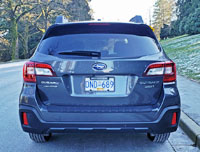
CarCostCanada was reporting up to $3,000 in additional incentives for 2019 Outbacks at the time of writing, while you’ll also find trim, package and option prices there, as well as rebate information and even dealer invoice pricing that could save you thousands when you sit down to negotiate, therefore you really should consider a 2019 unless you really want the updated version.
Choosing the new replacement Outback or soon to be replaced model shouldn’t solely be up to finances, unless budget limitations demand, but I still don’t see most buyers of the 2020 version sold merely on styling. After all, while they’re obviously different when seen side-by-side, the updated model is no radical departure. In fact, I’d say it’s actually less rugged looking at a time when most car-based crossover SUVs are working overtime to pretend otherwise.
Inside, it gets the mainstream volume sector’s largest centre touchscreen at 11.6 inches, positioned vertically instead of horizontal, as with this 2019 model’s still amply sized 8.0-inch touchscreen. I won’t go into too much detail about the 2020 model, being that I haven’t tested one yet, but suffice to say the new centre display could very well make moving into the latest Outback worthwhile all on its own.
Then again, I could see someone choosing a 2019 Outback just to acquire my test model’s wonderful 3.6-litre six-cylinder engine, which is sadly on its way out of the entire Subaru lineup. It has recently only been available in upper-crust Outbacks and top-tier versions of the brand’s Legacy mid-size sedan, but the advent of Subaru’s new Ascent mid-size three-row crossover SUV last year, and its lack of H6 power, initially signified an uncertain end to six-cylinder performance within blue-oval, silver star products, and now the 2020 Legacy and Outback have confirmed such.

Looking back, Subaru’s flat-six came into being as an option for the 1988–1991 XT (Alcyone VX) sports coupe, and was based on the brand’s four-cylinder of the time. It was upgraded for that model’s successor, the 1991–1996 SVX (Alcyone), a car I tested and was thoroughly impressed by way back in ’94. Next came the EZ30, which was a complete engine redesign notably nearly as compact as the EJ25 four-cylinder of the era, the smaller 3.0-litre version being optional in Legacy/Outback models from 2002/2001-2008/2009, and the almost identically sized yet more formidable 3.6-litre EZ36 available optionally for respective 2009 and 2010 models. Both versions of the EZ were used for the new Ascent’s three-row crossover SUV predecessor, incidentally, the 2006-2007 Tribeca integrating the smaller version and 2008-2014 versions using the bigger engine.
As it is, 2019 Outback engines include a base 2.5-litre four-cylinder good for 175 horsepower and 174 lb-ft of torque, plus the 3.6-litre H6 I’ve already talked about a length, except for output figures that measure up to 256 horsepower and 247 lb-ft of torque. For 2020, the entry-level 2.5i gets a total overhaul including 90 percent of its components replaced for 6 more horsepower and 2 lb-ft of additional torque, which now equal 182 horsepower and 176 lb-ft of torque, while the aforementioned Ascent’s new 2.4-litre turbocharged four-cylinder engine is optional as is its impressive 260 horsepower and 277 lb-ft of torque, which equals a small increase of 4 horsepower yet a robust 30 lb-ft of added torque over the old six-cylinder engine.
As you might expect, the updated 2020 engines are more efficient than their predecessors too, with the current 2019 Outback 2.5i achieving an estimated 9.4 L/100km city, 7.3 highway and 8.5 combined compared to 9.0, 7.1 and 8.0 for the new 2020 base engine, which is an obvious gain, while the 2019 Outback 3.6R manages a claimed 12.0 L/100km city, 8.7 highway and 10.5 combined rating compared to a much thriftier 10.1, 7.9 and 9.0 respectively for the new turbo-four. While Subaru certainly deserves credit for delivering such major gains in both efficiency and performance, I’ll miss the six-cylinder’s smooth, refined operation and throatier growl at higher revs.
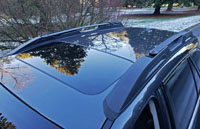
The brand’s High-Torque Lineartronic CVT (continuously variable transmission) is smooth too, and thanks to its ability to shift through its eight forward “gears” just like a conventional automatic, even via steering wheel paddle shifters, it’s relatively sporty as well. Then again, when revs climb higher it’s not quite as convincing as a sport model, which meant I didn’t end up using those paddles as much as I would normally have.
Either way the Outback 3.6R is no slouch off the line and fully capable of passing slower traffic on the freeway or better yet, a winding two-lane highway, and to that end it’s a pretty good handler too, even when pushed through tight curves at high speeds, but this said it’s no WRX STI. Of course, few vehicles can keep up to Subaru’s most famous performance model, let alone tall wagons primarily designed for comforting their occupants. Its comfort-oriented attitude is why I left the Outback’s super-smooth transmission is Drive and just enjoyed the ride more often than not. Its suspension is wonderfully compliant, making it perfect for managing rough backcountry roads and trips to the ski hill, plus of course overcoming some of the worst trails anywhere, those dreaded inner-city lanes.
If I were to claim Subaru’s standard full-time symmetrical all-wheel drive as the best AWD system in the mainstream industry I wouldn’t be alone, especially when factoring in “X-MODE” that controls the engine’s output, the transmission’s shift points, the AWD system’s torque-split, plus the braking and hill descent control systems so as to overachieve when off the beaten path. Obviously the Outback won’t walk away from a Jeep Wrangler on a level 8 or 9 trail (it wouldn’t even make it five feet on a level 8 or 9 trail), but its highly advanced AWD system and better than average 220 mm (8.7 inches) of ground clearance give it an advantage over most car-based crossover competitors when the going get tough.
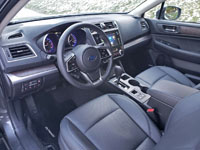
I’m sure you can imagine that I’m intrigued by the new 2020 Outback and want to get behind the wheel, something I’ll be doing next week. Of course, its bigger centre touchscreen will be impressive, and I’m guessing Subaru will make improvements in refinement as well. Nevertheless it’ll need to be particularly good to beat the current model’s near premium details, such as fabric-wrapped A-pillars, soft synthetic dash-top and instrument panel that’s contrast-stitched and continues all the way down each side of the centre stack, padded door uppers, inserts and armrests front to back, and its leather upholstery with contrast stitching in my near top-line Limited tester.
The Outback Limited’s leather-clad steering wheel looks and feels great, the latter thanks to ideally shaped thumb spats. The comprehensive switchgear on the 9 and 3 o’clock spokes are high-quality too, while all of the interior’s buttons, knobs and switches are good, with the audio and two-zone auto HVAC dials on the centre stack especially so.
Some of Subaru’s biggest gains in recent years have been in the electronics department, with this 2019 Outback not as mind-blowing as the 2020 model, but still on par with rivals. Both 2019 and 2020 models utilize relatively conventional primary gauge clusters sporting a circular analogue tachometer and speedometer to the sides of a tall, vertical multi-information display (MID), but the 2020 car waves goodbye to the sportier dual-binnacle motorbike-like gauge design now in use, for a much more conventional look that I find a tad disappointing when focused on base trims, but this said the 2019 model’s 5.0-inch optional MID can now be upgraded to a full 12.3-inch digital instrument cluster in the 2020 car.

What this means for those interested in the outgoing 2019 Outback, particularly in Limited and Premier trims, is a gauge cluster that’s hardly more exciting than what you’ll find in more basic 2.5i, Convenience and Touring models, but the base 3.5-inch MID gets replaced by a significantly better colour 5.0-inch version when EyeSight gets added to the mix (I’ll talk about EyeSight shortly), but turn your eyes to the centre stack and it’s a completely different story.
The most basic 2020 Outbacks start off with a 7.0-inch touchscreen, which is an upgrade from the 2019 model’s 6.5-inch centre monitor, while the top-line 2019 model gets a reasonably large 8.0-inch touchscreen, as noted earlier. I can understand you may have seen something even more impressive if you’ve just stepped out of the updated Outback or something premium from Germany, but my tester’s infotainment interface was still well laid out and plenty attractive due to lots of gloss black surfacing around the touchscreen so that it all blends nicely together as if it’s one oversized display, while the background graphics offer up Subaru’s trademark starlit blue night sky and bright, colourful smartphone/tablet-style candy drop buttons for choosing functions.
The backup camera is very good, helped along by active guidelines, while features include Android Auto, Apple CarPlay and Subaru’s own StarLink smartphone integration. Of course, the usual AM/FM/CD/MP3/WMA audio sources can be found too, plus satellite and Aha radio, USB and aux ports, SiriusXM advanced audio services, SiriusXM Travel Link, and Bluetooth with audio streaming. It all gets funneled through four speakers in lower trims and six speakers in Touring trims and above, while the latter also includes the aforementioned 1.5-inch larger touchscreen and a second USB port.
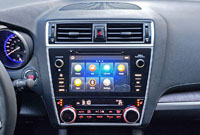
Being that you won’t be able to factory order a 2019 Outback, I won’t delve into all the trim line details, but some as yet mentioned features found in my Limited trimmed test model include 18-inch alloy wheels, auto on/off LED headlights with steering-responsive capability, fog lights, welcome and approach lights, proximity keyless access, pushbutton ignition, brushed aluminum front doorsill protectors, authentic looking matte woodgrain and silver metallic interior accents, auto-dimming side and centre mirrors, a heated steering wheel rim, three-way heatable front seats, a navigation/route guidance system, dynamic cruise control, a 10-way powered driver’s seat with power lumbar and two-way memory, a four-way power front passenger’s seat, a universal garage door opener, a great sounding 12-speaker, 576-watt Harman/Kardon audio system, a power glass sunroof, two-way heated rear outboard seats, a power rear tailgate, plus more.
Those EyeSight advanced driver assistance systems mentioned earlier include pre-collision braking, pre-collision brake assistance, pre-collision throttle management, lane departure warning, lane sway warning, lane keep assist, lead vehicle start alert, reverse automatic braking, adaptive cruise control, and auto high beams.
My as-tested Limited 3.6R with the EyeSight tester can be had for $41,395 plus freight and fees, which is $1,500 more than the Limited 3.6R with no EyeSight, while that model is also $3,000 more than Limited trim with the four-cylinder powerplant. A base Outback 2.5i can be purchased for just $29,295, incidentally, while additional 2019 trims include the $32,795 Touring 2.5i and $39,295 Premier 2.5i, the latter trim coming standard with EyeSight. You can upgrade Touring trim with the Eyesight package and engine upgrade, but, no-cost colour choices aside, the flat-six is the only available option with Premier trim.
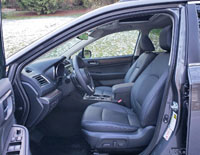
The 2019 Outback’s retail price ranges from $29,295 to $42,295, but take note that up to $3,000 in additional incentives were available at the time of writing, so be sure to check out our 2019 Subaru Outback page for all the details, plus pricing, rebate, and dealer invoice pricing that could save you thousands.
As I explained when starting this review, the Outback can manage mid-size SUV-levels of cargo, so as you might expect there’s also ample space for adult passengers in both rows of seats. It’s comfortable too, the front seats ideally shaped for optimal support, particularly at the lower lumbar region, while the side bolsters also support well laterally. The rear seating area is amply large as well, particularly with respect to headroom.
Also important, the rear compartment is just as refined as the front. Along with surface treatments and other details finished nicely, a large armrest flips down from the centre position filled with well designed cupholders that actually hold drinks in place when underway thanks to rubber grips (most are nowhere near as useful), while the backside of the front centre console features a covered compartment with two USB chargers plus an auxiliary plug, as well as a set of rocker switches for the previously noted rear seat heaters and the rear HVAC vents. Rear passengers needing overhead light will appreciate the reading lamps above, while each door panel includes a big bottle holder.

It seems just about perfect to finish this Subaru Outback review on such a practical subject matter, even after factoring in the premium-like cabin, luxuriously smooth powertrain and equally plush ride. It’s a crossover wagon/SUV that’s actually better than advertised, and that makes it a truly rare commodity. Believe me, you’ll be well served whether you opt for this impressive 2019 Outback or the new 2020 version.
Story credit: Trevor Hofmann
Photo credits: Karen Tuggay
